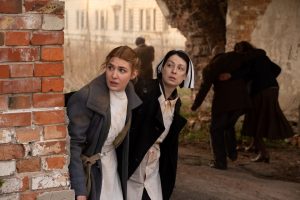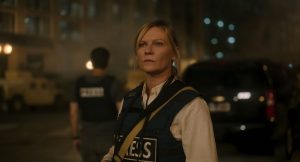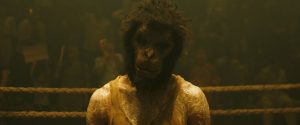Reviews include Irena’s Vow, The Beast, and Before I Change My Mind.
An Interview With: Valerie Buhagiar
April 18, 2019
“It’s scary to make a film about God and limbo.”
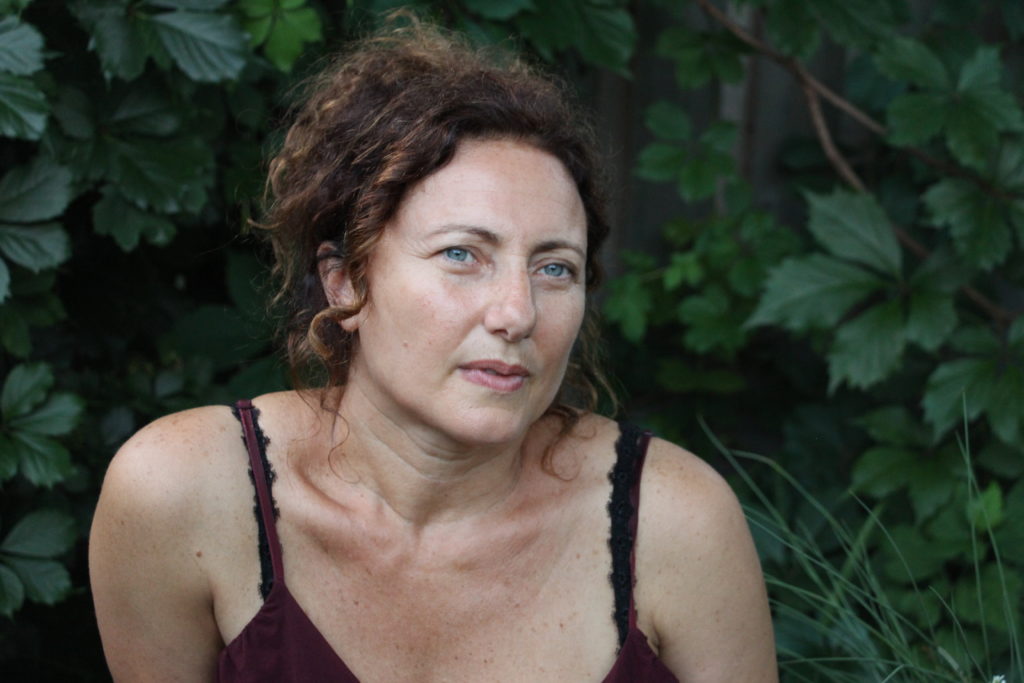
Malta-born, Toronto-raised filmmaker Valerie Bugahiar came up as part of the Toronto New Wave, starring, alongside Don McKellar, in Bruce McDonald’s first two features, Roadkill (1989) and Highway 61 (1991). She continued to work as an actor in theatre and film for several years before directing her first short, The Passion of Rita Camilleri (1993), which marked the beginning of a very personal filmography unlike anything else in Canadian cinema.
Inspired by August Strindberg’s A Dream Play and drawing upon her experiences growing up in a devoutly Catholic, immigrant, working-class family in the Junction, Buhagiar’s ninth film and second feature, It’s Hard to Be Human, follows Agnes (Nina Gilmour), a young woman in a downward spiral who regards her largely absent father (musician Tom Wilson, of Junkhouse and Blackie and the Rodeo Kings) as God. Agnes experiences moments of grace, despair, fury, addiction, loss and hospitalization, though not necessarily in that order: the film unfolds in a series of brief, visceral, visually arresting scenes that fuse objective reality with the fantastical.
I’ve known Buhagiar for a few years. In that time have come to regard her as a sort of practical seeker, someone open to all variety of spiritual experience and yet able to speak about such experiences in simple, concrete terms. Our conversation transpired just as Buhagiar is preparing to travel to Malta to shoot her next feature.
It’s Hard to Be Human opens at the Carlton on April 19th, 2019.
José Teodoro: It’s Hard to Be Human isn’t psychological drama. We don’t watch it looking for concrete causality. I’m not even sure it has a plot. It seems more like a vast canvas or tapestry that you illuminate only in fragments of, one at a time.
Valerie Buhagiar: Huh. That makes a lot of sense. Thanks for explaining that to me! [Laughs]
You’re welcome! Maybe we’d better start at the beginning.
Sure. I was looking for a play to make into a film. Someone suggested August Strindberg’s A Dream Play. I read it and this one line, “It’s hard to be human,” which I believe is spoken by a child, vibrated so deeply in me, hooked me. I dove in. I wrote the first draft of the screenplay and it was as sprawling as the play, spanning the whole of the 20th century, moving through it decade by decade. There were castles and clouds and oceans. Somewhere along the way I applied for funding and — surprise! — didn’t get it. So I put it aside and, in a moment of frustration, wrote my first feature, The Anniversary, at my kitchen table in three days, knowing it was going to be set in my house, that it was going to be cheap-cheap-cheap. This was 2013. I called some friends, said we’re going to try crowd-funding, told everyone we’re going shooting December 1st. This was in August. Who we get, we get. Whatever money we get, we get. Which wound up being $15,000. And we made the film.
Boom. You wanna make a movie, set a date.
Exactly. So that happened. Then I came back to It’s Hard To Be Human. At the time I was going through this therapy — EMDR, or Eye Movement Desensitization and Reprocessing — and it prompted me to re-conceive the project as something more personal. That’s how we settle on Agnes, this very pious young woman who decides to break ties with her spiritual life, goes to the deep end, the dark end, and then finds her own way out. When working on a script, of course I try to provide structural markers — such as a discernable plot, which, as you noted, is absent — to help my collaborators and the production. But by the time I reached the end of this new script, it just didn’t seem to matter that much if there was a plot. And once I started to work with my editor, Peter Strauss, chronology started to go all over the place. The exciting part for me is the limbo part, the hospital. Initially, it seemed so important to tell the story of how she got into limbo. And then it didn’t.
The script was more linear originally.
Yes. We dismantled it in the editing suite.
Let’s talk more about limbo. Agnes’ father pithily describes this place as “the space between life and death, where choices are made.” Often in life we don’t make decisions until our time is nearly up. But this idea is also reflected in your process. It was only when you’d exhausted a huge number of ideas in your previous draft and received no support, when you were left in limbo, as it were, that you arrived at a place where this new thing could take shape.
Yes. I needed to get to a kind of limbo. Life mostly prevents us from entering this place. You know, the average person wakes up, does their coffee, their morning routine, gets to work, bam-bam-bam, day’s done, leisure time, maybe TV, a book, friends, et cetera, and done. Where is that space where you’re alone, where you’re in touch with your impulse, which to me means choice?
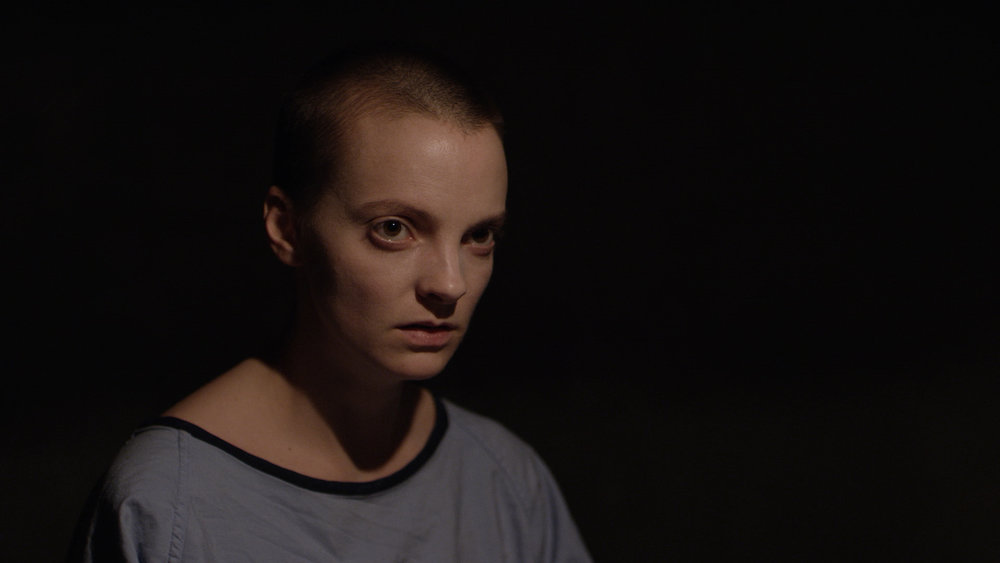
I suppose we fill up our lives so as to avoid that space. It always grosses me out to portray artists as being somehow being more enlightened — what a joke — but I suppose something that dictates a creative life is that it becomes your job to cultivate these spaces.
I need so much space. And it’s so hard to explain that to people, that it isn’t that I don’t love you or care for you…
You’ve been reading my mail.
Right?
Tell me more about EMDR, which you implied was a catalyst for this project.
I did it for nine years. It starts with mapping out your family as far back as you can go, and other important people in your life. My doctor used aromatherapy, which ignites memory through smell. So I see an image of my earliest memory with one eye, then my doctor waves her hand, I see it with the other eye, suddenly we have a different angle, different perspective. Long story short, it isn’t that you forget the memory but, rather, that it no longer paralyzes you. You’re desensitized to it. Anyway, after nine years of this my doctor said, “You’re good to go.” I panicked and told her I was not good to go. And right in that moment another memory came. I don’t know how it happened. It had to do with church. It had to do with my father. It created a real confusion about the patriarch. My father felt like God to me. So from this point I take a deeper interest in this power dynamic between daughter, father and God, and what the daughter might do to either win the attention of God-father or how, alternately, she might just give up. I was an extremely pious girl. I was thinking of becoming a missionary. Then, when I was 16, I began to scrutinize my religion more closely. I realized that God didn’t like everybody. God meaning the church. Homosexuality, premarital sex: that these things weren’t accepted pissed me off. That’s when I started to find my own way. I didn’t see a middle ground. In Catholicism, it seemed that there was just good and evil. I used to think that anyone who wasn’t Catholic was wrong. That was all I knew.
Were you exposed to much in the way of movies as a kid?
God no. We didn’t have much money. We were working-class immigrants. We didn’t have a TV for quite a while. My first movie, the first one we were all taken to, was The Ten Commandments. [Laughs] It wasn’t until I started to help my brother with his paper route that we were able to save up to go see some Clint Eastwood movies — his choice. I didn’t really see films until after theatre school.
I can’t help but think about Paul Schrader, who grew up in Grand Rapids, Michigan, in this Calvinist community where he has no exposure to cinema, but then he eventually breaks away, sees as much as he can, becomes a filmmaker, and what comes out in his filmmaking, to this day, contains the detritus of this restrictive, intense, but fully engaged religious upbringing, with all the guilt and judgment and rage that comes with that. Rage is also in the mix in It’s Hard To Be Human.
Oh, yeah! Agnes is 19. She feels abandoned. Her mother is self-medicating and really just lives to die. Meanwhile her father keeps disappearing and even when he is around is giving attention to Agnes’ best friend Victoria. Which is something I think doesn’t work in the film. I think it’s misunderstood.
Dad’s relationship with this teenage girl?
Yes. He goes to Victoria because she’s enlightened. He wants to learn enlightenment. People tend to think he might be a pedophile, but he’s not. It’s Victoria’s light that everyone wants. There’s that line of the brother’s about how everyone wants a piece of Victoria. It’s not because she’s a hottie. It’s because she’s wise. And innocent. People are drawn to innocence. People like to squish innocence. To chew it up.
I confess I wondered about Dad’s relationship to Victoria. He’s this video artist, he seems largely absent, and yet wields this power over Agnes. I was curious why you chose to have him look like an aging biker.
First of all, I figured if God is the Creator than he’s gotta be making something, so he’s an artist. We actually shot a whole scene where he’s directing, but we cut it. It just didn’t work. Visually, I felt Tom [Wilson] just had the look that most of us associate with God or Jesus, the long hair and beard. I also liked that Tom could project the image of a rock star. Because who are our gods now if not rock stars, rap stars, musicians. I didn’t know Tom well. Someone suggested him and I liked his vibe. I initially wanted an indigenous actor. I asked Gary Farmer, who lives down in New Mexico. Brilliant actor. Seems like a great guy. He answered me about three months later and said, “Yeah, I’ll do this.” Of course, I’d already shot the film. But, funny enough, Tom, just prior to shooting, found out that he’s Mohawk. He’s one of those Sixties Scoop kids. He wrote a book about it called Beautiful Scars.
To get back to Victoria for a moment, she speaks one of the film’s more enigmatic lines: “Singing is like praying twice.” What does that line mean to you?
A nun at my high school used to say that. Have you ever sung in a choir? Singing has for me always seemed like the closest thing to an expression of the soul — which I realize is wrong to say, because if you’re mute that doesn’t mean you don’t have a soul — but I have this sense that when you pray outwardly, as opposed to silently, to yourself, it vibrates in a more profound way. There’s science to this, I promise. [Laughs] When you put energy into a thought, that’s one thing, but when you release that though into the world through song, that doubles it.
When someone known as an actor turns to directing, they typically choose material that functions as an actors’ showcase, dramas with scenes in which actors can get all worked up about something, or a character study. You, by contrast, have made a film that’s idea-driven, montage-heavy, puzzle-like. Which makes me wonder about how you worked with your lead actor, Nina Gilmour. Could she see the picture? Did she read the script and say, “I understand what you need me to do”?
She understood to a certain point. Then I filled her in on specific details regarding where each scene came from. I spoke to her about style. We worked closely. I bring the actors to my house and we rehearse a lot, all of which I tape and then use when talking with my director of photography. I also use a lot of images, photographs, and other films. You know, a film that really helped me think about It’s Hard to Be Human, a film that really moved me, which made me weep, was The Tree of Life — which is a film a lot of my friends hated and wrote off as pretentious. So it’s scary to make a film about God and limbo and ask these questions. I know that it’s not going to be everyone’s cup of tea.
I thought about Tree of Life a lot while watching It’s Hard to Be Human. In fact, I wanted to ask you whether you felt like this film was following a sort of tradition — one practiced by a pretty small number of filmmakers historically — that we might call spiritual cinema?
Not at all. Probably because of my lack of knowledge. I don’t come to this as a cinephile. I started as an actor and didn’t have ambitions to direct. At some point I had a story to tell and wondered if it could be a play. That would have been easier, since I knew how to do it. I had no education as a filmmaker, aside from being on film sets. But as I thought through the images I wanted to transmit in this story I realized it wanted to be a film. So I made a film — The Passion of Rita Camilleri — and every film since has been about finding the language to explore a theme or idea. Like Tell Us the Truth, Josephine, in which I walk across Canada on stilts as a way to think about immigrants. Everything I want to do is driven by images, themes, ideas. I’m not that interested in filming people talking. Which is funny because I talk all the time! [Laughs] But I can also sit by a window and look at things for hours.
You like light. That’s pretty clear.
I love light. But a cinematic tradition? I don’t know. I wanted to give people a visceral experience. Horror movies do that.
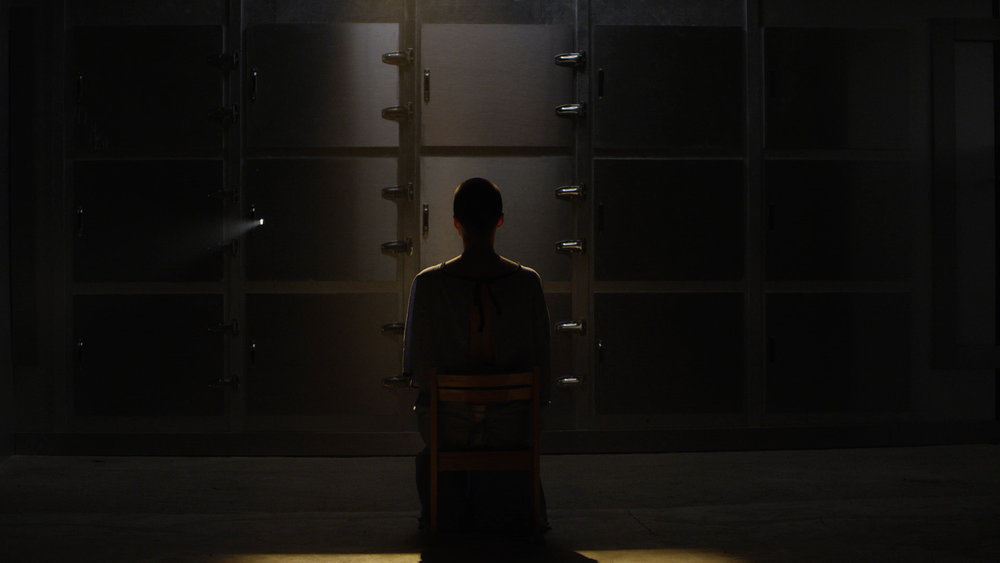
Well, It’s Hard to Be Human isn’t entirely distinct from a horror film. It’s about corporeality, proximity to death, primal fear, the supernatural.
You’re right. And horror is more marketable!
I think It’s Hard to Be Human could be especially interesting or salient for recovery groups.
That’s so interesting. I guess it’s to do with facing the void. What happens to Agnes happens to all of us. We all face some kind of void, right? What is that void about? We’re not connecting with people or nature. When you can’t connect there’s loneliness and that loneliness is a void. We fill that void with other things. Could be sex, drugs, alcohol, work, exercise…
Could be religion.
It could be religion. Whatever it is that winds up blocking the truth. Agnes can’t connect, so she tries anything she can to fill up.
A significant part of her journey seems to be a matter of seeking arguments against suicide.
Yeah. She pretty much wants it. Life isn’t worth living anymore if she can’t have a spiritual life. In her way of perceiving things, it’s a way to get closer to her father. Even though suicide is the greatest sin.
Is filmmaking itself for you in any way a spiritual practice?
Hm. Theatre is, for sure. With film, I like to set a certain type of environment where everyone feels safe. In certain environments that comes easy. When I’m shooting in my house, say, where I can set the vibe, play some music, feed everyone, make everyone feel calm, all of that. But with It’s Hard to Be Human, we had major challenges, a lot of exteriors, a lot of noise. So it was difficult to find that spiritual place. The crucial thing is that I feel cool as a cucumber, so everyone else feels comfortable. The word “comfort” means “with strength.” You have to be comfortable, to be strong, if you’re going to work in the most creative possible way. Not everything I try to do to provide comfort and strength always works. Sometimes I have to recognize when something isn’t working for someone and just step back and accept it.
Which is a very spiritual-practice kind of thing to do.
Yes. It’s a question of surrendering. Making films, you have to learn how to surrender.
— Interview by José Teodoro

